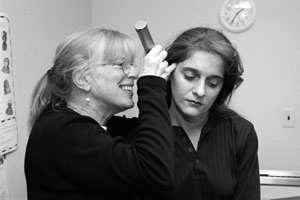By Laurel Thomas Gnagey

A look at classified ads in any newspaper reveals evidence of the growing shortage of health care workers, particularly nurses. A recent Crain Communications Modern Health Care article (May 27, 2002) cites a study by the American Hospital Association, that says 89 percent of the nation’s hospitals report “significant workforce shortages, with a 13 percent vacancy rate for nurses.”
U-M Health System (UMHS) has been very successful in hiring some 200 nurses since January, but a glance at the nearly 150 postings in the Jobs section of the Record shows that the shortage continues to be felt at U-M hospitals and clinics.
New UMHS Chief of Nursing Services Marge Calarco says the problem is not as bad nor as longstanding in Michigan as it is in coastal areas like California, but the shortage has been present in the state for two to three years, causing UMHS to take a hard look at how it can attract and keep valuable nursing personnel.
“UMHS is still very well positioned to attract nurses across the state and from other areas of the country,” says Calarco, whose full title is associate hospital director for patient care services and chief of nursing services. UMHS pays more than most, and its benefit package is second-to-none, but Calarco says that while compensation is important, it is not the only factor that makes the system an attractive one.
“We offer a breadth of opportunities for people that other places simply cannot because we are extremely large, extremely complex and broad in scope. We take care of every patient population you can imagine. So we offer nurses the ability to develop their careers and develop themselves.”
Professional development activities start with students in nursing programs and continue with fresh out of college nurses who are mentored by more seasoned professionals. The veteran nurses serve as preceptors or teachers. Opportunities remain throughout careers with cross training for other specialties and development of nurse leaders.
One of the newer initiatives is called “Discover Nursing at Michigan.” Calarco says the program connects freshmen nursing students with UMHS by allowing them to shadow a nurse. This not only involves students from the U-M nursing program, but means developing and strengthening relationships with other colleges and universities.
More recently the program was expanded to include upper classes of students and nurses who have been out of practice for some time. The Health System also partnered with Madonna College to offer a refresher course for nurses for which the system eventually will pay the entire tuition if the nurse signs on to practice at UMHS.
While Calarco says recruitment is important in the competitive marketplace, keeping staff members also is a challenge, particularly at a university health system where many of the workers are here because they or their spouses are earning degrees. Since becoming interim head of nursing in 2000, and permanent chief recently, Calarco has placed considerable emphasis on retention.
Another study, cited by Modern Health Care (June 17, 2002), says 92 percent of 1,200 nurses surveyed had witnessed “disruptive physician behavior” and at least 30 percent of them knew of a nurse who had resigned because of poor treatment by a physician. Calarco says in most areas UMHS physicians treat nurses as respected members of the health care team so that incidents like this are not prevalent here.
“We don’t conceptualize ourselves, nurses at Michigan, as subordinate practitioners,” says Calarco. “The relationship with physicians is a critical one. When I have brought these issues up at executive medical staff meetings, there hasn’t been a time that physicians haven’t said, ‘What are we doing to drive nurses away? What can we do differently to recruit and retain nurses?’ ”
Among the retention initiatives are efforts that focus on the role nurses play in the UMHS decision-making process. Calarco says nurses are critical patient care providers and, as such, are partners with physicians and other health professionals in delivering that care. A recently developed structure has created a nurse-physician dyad, or two-person management team, for each hospital or clinical unit. The team’s goals are to foster communication and partnerships, and to design joint work processes and manage budgets.
“They help manage issues together. Some dyads are very far along, some are evolving slowly,” Calarco says.
After an e-mail contact with nurses a year ago in which Calarco addressed the need for more staff, UMHS nursing employees told her, ‘ “Thank you for acknowledging that recruitment is important but what about us?’ ”
Recognizing that nurses were working long hours in the past, including considerable mandatory overtime, staff members were invited to attend meetings to offer input on addressing recruitment and retention. Over 100 volunteers came forward, says Calarco, and many have continued to participate in team initiatives to improve the work environment.
Other efforts at retention involve recognizing those nurses who have longevity. A special celebration for preceptors was held recently to thank those who mentor others. Calarco says feedback was extremely positive.
In May, UMHS brought 250 people together to “create our nursing vision and action plan.” This included nurses from across the system, physicians, department heads, patients and school of nursing faculty. “We believed that to plan our future together we had to have a microcosm of the entire system,” Calarco says.
“We are serious about bringing all voices to the table and addressing staffing, and we have to say that aloud. We are going to make a major investment around staffing. We have to hire enough staff to have a reasonable work load for nurses and a reasonable patient to nurse ratio so the patients are getting the best care possible.”

